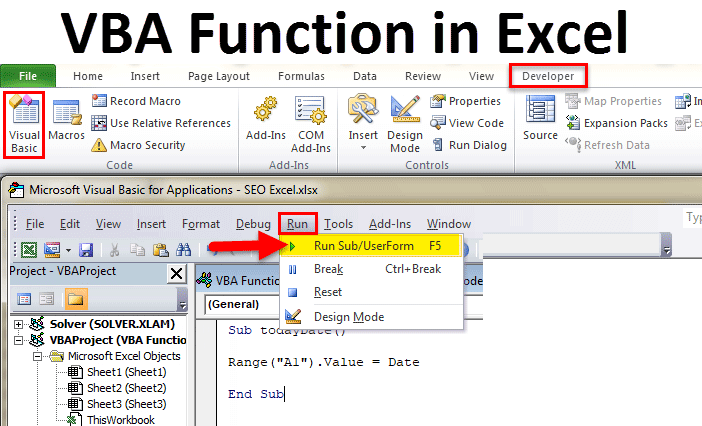

#EXCEL VBA CODE LIBRARY PEARSON WINDOWS#
Otherwise, you will need to use the Windows Sleep API function if you are working in e.g. As an alternative, you may choose to wrap the required Excel-based functions or Do…Loop statements into a custom function to make them easier to use/remember (with the added benefit of making your code easier to read): Public Sub PauseExcel(Dim waitInSeconds As Long)Īpplication.Wait VBA.DateAdd("s", waitInSeconds, VBA.Now) However, it is also important to note that there is a very small (but real) risk that your Office application will freeze if your computer has a hiccup. I most often use the Sleep function (system32.dll) to pause code execution, because it is the most accurate and legible of the three methods. The Do.Loop result is also faster than the Excel-based functions, but slower than the Sleep function: It is cumbersome compared to the previous two options, but less so if you wrap it into an easy to remember and use procedure. However, you will be able to execute Public sub procedures from the Developer menu of the xlRibbon. While active, you can do normal sheet and cell operations, but you will not be able to execute additional code directly from the Visual Basic Editor. Private Declare PtrSafe Function GetTickCount Lib "kernel32" () As Long Instead of putting the process that the Office application is running on to sleep, it calls the CPU clock counter directly using another API call: ' Returns the amount of milliseconds that have elapsed since Windows was started: Within the loop, DoEvents is called to allow keyboard and mouse events to occur normally. These examples will help you automate your tasks and inspire you to sharpen your VBA skills. Personally, I have never encountered a real-world scenario where I needed to use this method, but it exists: Public Function WaitAsync(numberOfSeconds As Long)Īpplication.EnableCancelKey = xlErrorHandlerĮndTick = GetTickCount + (numberOfSeconds * 1000) Supercharge your productivity with these useful macro codes. Demo Resultįor this method, accuracy improves by a factor of ~10 over the Excel-based functions:

Below you can find a complete overview.The key cannot be used to break out of Sleep.
#EXCEL VBA CODE LIBRARY PEARSON HOW TO#
The application object gives access to a lot of Excel related options.ġ5 ActiveX Controls: Learn how to create ActiveX controls, such as command buttons, text boxes, list boxes etc.ġ6 Userform: This chapter teaches you how to create an Excel VBA Userform.īecome a VBA pro! You can find related examples and features on the right side of each chapter at the bottom of each chapter. In Excel VBA, you can refer to a specific variable (element) of an array by using the array name and the index number.ġ3 Function and Sub: In Excel VBA, a function can return a value while a sub cannot.ġ4 Application Object: The mother of all objects is Excel itself. A loop in Excel VBA enables you to loop through a range of cells with just a few codes lines.Ĩ Macro Errors: This chapter teaches you how to deal with macro errors in Excel.ĩ String Manipulation: In this chapter, you'll find the most important functions to manipulate strings in Excel VBA.ġ0 Date and Time: Learn how to work with dates and times in Excel VBA.ġ1 Events: Events are actions performed by users which trigger Excel VBA to execute code.ġ2 Array: An array is a group of variables.

In this chapter, learn how to create a simple macro.Ģ MsgBox: The MsgBox is a dialog box in Excel VBA you can use to inform the users of your program.ģ Workbook and Worksheet Object: Learn more about the Workbook and Worksheet object in Excel VBA.Ĥ Range Object: The Range object, which is the representation of a cell (or cells) on your worksheet, is the most important object of Excel VBA.ĥ Variables: This chapter teaches you how to declare, initialize and display a variable in Excel VBA.Ħ If Then Statement: Use the If Then statement in Excel VBA to execute code lines if a specific condition is met.ħ Loop: Looping is one of the most powerful programming techniques.

VBA ( Visual Basic for Applications) is the programming language of Excel and other Office programs.ġ Create a Macro: With Excel VBA you can automate tasks in Excel by writing so called macros.


 0 kommentar(er)
0 kommentar(er)
